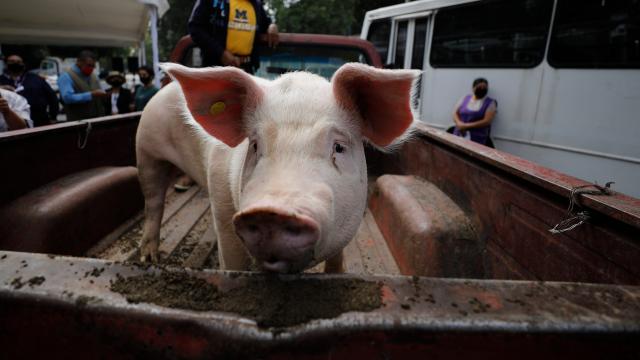U.S. government scientists have shown in the lab, for the first time, that pigs can become severely sick from a particular species of the Ebola virus, called Reston ebolavirus (RESTV). The virus is known for being the only species of Ebola not to sicken people so far. But the discovery suggests that it can still pose a grave threat to livestock, and the chances of it someday harming humans aren’t zero, either.
Reston was popularised in the 1994 nonfiction book The Hot Zone, written by Richard Preston. In it, Preston goes over the events of the first known Reston ebolavirus outbreak in 1989, when monkeys being used for animal research at a lab in Reston, Virginia began dying en masse. Several animal handlers and lab workers eventually tested positive for antibodies to the virus, but to everyone’s relief, none developed symptoms of the often fatal hemorrhagic fever that accompanies other Ebola viruses. At the time, Reston was considered a strain of another Ebola virus, but it’s now categorised as its own species of Ebola, one of six.
Over the years, research and other outbreaks have conclusively shown that Reston can sicken nonhuman primates. In 2008, evidence emerged that it might have been the culprit behind outbreaks of respiratory illness at several pig farms in the Philippines. At least six farm workers were thought to have been infected by the pigs, but, as before, these infections didn’t lead to any human illness. Still, the incident was alarming to epidemiologists.
Since 2008, there’s been only limited research looking at the connection between the Reston virus and pigs. This new study, published on Monday in the Proceedings of the National Academy of Sciences, was the work of scientists at the National Institute of Health.
Their results suggest that the Reston ebolavirus can indeed infect and seriously harm pigs. They gave the virus to young domestic piglets between the ages of three and seven weeks old, exposing them through the mouth and nose. The pigs developed severe respiratory disease, with most needing to be euthanised within a week’s time. What’s more, the pigs readily shed the virus in their respiratory tract, indicating that they could transmit the virus to others during that time.
“We conclude that RESTV should be considered a livestock pathogen with zoonotic transmission impacting on animal and perhaps even human health,” the authors wrote.
[referenced id=”1227062″ url=”https://gizmodo.com.au/2020/07/not-now-ominous-new-swine-flu-strains/” thumb=”https://gizmodo.com.au/wp-content/uploads/2020/07/01/xea1i24u54rtkhsqbz1s-300×169.jpg” title=”Not Now, Ominous New Swine Flu Strains” excerpt=”Researchers in China are sounding the alarm over strains of the influenza virus that have become common among some farm pigs — strains that have the potential to erupt into an easily transmissible pandemic in people, they warn. But while the threat is serious and worth keeping an eye on,…”]
To be clear, the risk to people is entirely theoretical for now, but it’s not impossible. Viruses like influenza already regularly cross over from animals like birds to pigs and then to people. Sometimes, this journey can result in a potent new flu strain that’s easily transmissible and disease-causing in humans. Other viruses — including the coronavirus that causes covid-19 — often originate in animals before mutating into a version that can become a nightmare for people. If pigs were to become a common reservoir of the Reston virus, it’s possible that strains could one day emerge and be transmitted to humans that become just different enough to make us sick.
There’s no need to panic right now. But if the covid-19 pandemic should teach us anything, it’s that we have to identify these viral threats long before they spill over into people if we want a chance at stopping them.
“The emergence of RESTV in pigs is a wake-up call as transmission into humans through direct contact with pigs or the food chain is a possibility,” the authors wrote.
